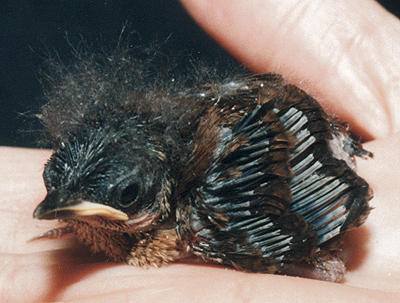Found a Baby Bird?
Nestling birds are very young birds. They may be either completely naked with eyes closed (technically called hatchlings), or may have some feathers. Sometimes you will see feathers encased in a shaft with feathers poking out of the end called pin feathers. Birds this age should be returned to the nest or placed in a makeshift nest, where their parents can continue to feed them throughout the daylight hours. The makeshift nest should be at least a few feet off of the ground and as close to the original nest site as possible. Holes should be placed in the container for drainage. Pictured below, Carolina wren nestling.
 Fledgling birds have developed most of their adult feathers, but are not yet skilled at flying. They follow their parents about, learning to forage for food and to avoid predators. Some species of songbirds become completely independent of their parents by two to three weeks. Others may be dependent for a full season. Fledgling birds are commonly found alone on the ground and may be mistaken for orphans; however, parents are typically close by, watching their young from a safe distance. It is best to monitor the baby bird from a distance or indoors to determine if the bird is truly orphaned as people or pets may keep the parents away. Pictured below, Carolina wren fledgling.
Fledgling birds have developed most of their adult feathers, but are not yet skilled at flying. They follow their parents about, learning to forage for food and to avoid predators. Some species of songbirds become completely independent of their parents by two to three weeks. Others may be dependent for a full season. Fledgling birds are commonly found alone on the ground and may be mistaken for orphans; however, parents are typically close by, watching their young from a safe distance. It is best to monitor the baby bird from a distance or indoors to determine if the bird is truly orphaned as people or pets may keep the parents away. Pictured below, Carolina wren fledgling.

Photos, Stock
If you are unsure if the bird you have found needs help please call a local wildlife rehabilitator.
We recommend:
Volunteers for Wildlife
Wildlife Advisory Telephone (516) 674-0982 during hospital hours or e-mail [email protected] after hours.

